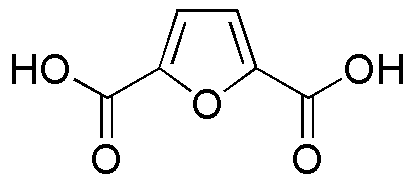2,5-Furandicarboxylic acid is widely utilized in research focused on:
- Biodegradable Plastics: This compound serves as a key building block for the production of bio-based plastics, offering a sustainable alternative to petroleum-based materials. Its use in creating polyesters can significantly reduce environmental impact.
- Textile Industry: It is employed in the synthesis of fibers and textiles, enhancing the durability and performance of fabrics while maintaining eco-friendliness, appealing to manufacturers aiming for sustainable production.
- Food Packaging: The compound is used in developing biodegradable food packaging materials, which help reduce plastic waste and improve food safety by providing a non-toxic barrier.
- Pharmaceuticals: In the pharmaceutical sector, it acts as an intermediate in the synthesis of various drug compounds, facilitating the development of new medications with improved efficacy.
- Adhesives and Coatings: Its application extends to the formulation of adhesives and coatings that are both effective and environmentally friendly, providing strong bonding properties while minimizing harmful emissions.
General Information
Properties
Safety and Regulations
Applications
2,5-Furandicarboxylic acid is widely utilized in research focused on:
- Biodegradable Plastics: This compound serves as a key building block for the production of bio-based plastics, offering a sustainable alternative to petroleum-based materials. Its use in creating polyesters can significantly reduce environmental impact.
- Textile Industry: It is employed in the synthesis of fibers and textiles, enhancing the durability and performance of fabrics while maintaining eco-friendliness, appealing to manufacturers aiming for sustainable production.
- Food Packaging: The compound is used in developing biodegradable food packaging materials, which help reduce plastic waste and improve food safety by providing a non-toxic barrier.
- Pharmaceuticals: In the pharmaceutical sector, it acts as an intermediate in the synthesis of various drug compounds, facilitating the development of new medications with improved efficacy.
- Adhesives and Coatings: Its application extends to the formulation of adhesives and coatings that are both effective and environmentally friendly, providing strong bonding properties while minimizing harmful emissions.
Documents
Safety Data Sheets (SDS)
The SDS provides comprehensive safety information on handling, storage, and disposal of the product.
Product Specification (PS)
The PS provides a comprehensive breakdown of the product’s properties, including chemical composition, physical state, purity, and storage requirements. It also details acceptable quality ranges and the product's intended applications.
Certificates of Analysis (COA)
Search for Certificates of Analysis (COA) by entering the products Lot Number. Lot and Batch Numbers can be found on a product’s label following the words ‘Lot’ or ‘Batch’.
Número de catálogo
Número de lote/lote
Certificates Of Origin (COO)
This COO confirms the country where the product was manufactured, and also details the materials and components used in it and whether it is derived from natural, synthetic, or other specific sources. This certificate may be required for customs, trade, and regulatory compliance.
Número de catálogo
Número de lote/lote
Safety Data Sheets (SDS)
The SDS provides comprehensive safety information on handling, storage, and disposal of the product.
DownloadProduct Specification (PS)
The PS provides a comprehensive breakdown of the product’s properties, including chemical composition, physical state, purity, and storage requirements. It also details acceptable quality ranges and the product's intended applications.
DownloadCertificates of Analysis (COA)
Search for Certificates of Analysis (COA) by entering the products Lot Number. Lot and Batch Numbers can be found on a product’s label following the words ‘Lot’ or ‘Batch’.
Número de catálogo
Número de lote/lote
Certificates Of Origin (COO)
This COO confirms the country where the product was manufactured, and also details the materials and components used in it and whether it is derived from natural, synthetic, or other specific sources. This certificate may be required for customs, trade, and regulatory compliance.

